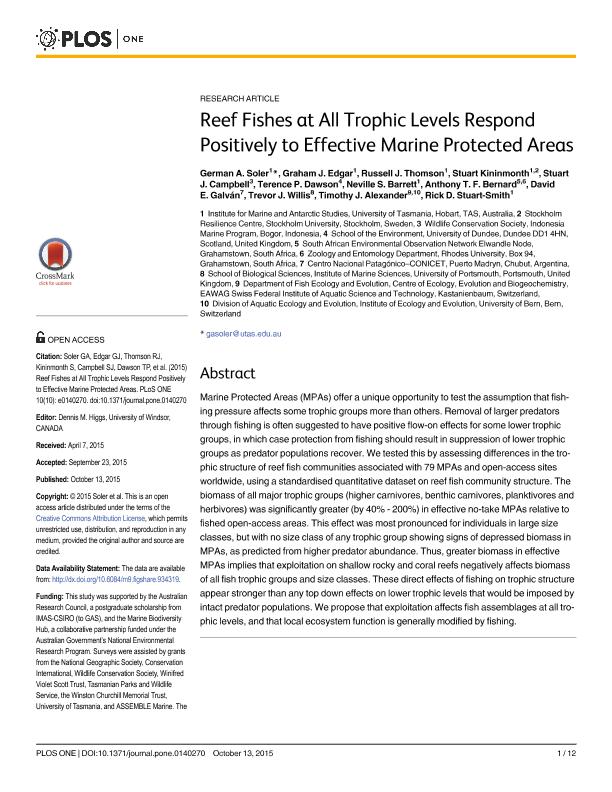Mostrar el registro sencillo del ítem
dc.contributor.author
Soler, Germán A.
dc.contributor.author
Edgar, Graham J.
dc.contributor.author
Thomson, Russell J.
dc.contributor.author
Kininmonth, Stuart
dc.contributor.author
Campbell, Stuart J.
dc.contributor.author
Dawson, Terence P.
dc.contributor.author
Barret, Neville S.
dc.contributor.author
Bernard, Anthony T. F.
dc.contributor.author
Galvan, David Edgardo

dc.contributor.author
Willis, Trevor J.
dc.contributor.author
Alexander, Timothy J.
dc.contributor.author
Stuart Smith, Rick D.
dc.date.available
2019-07-05T19:28:38Z
dc.date.issued
2015-10
dc.identifier.citation
Soler, Germán A.; Edgar, Graham J.; Thomson, Russell J.; Kininmonth, Stuart; Campbell, Stuart J.; et al.; Reef fishes at all trophic levels respond positively to effective marine protected areas; Public Library of Science; Plos One; 10; 10; 10-2015; 1-12; e0140270
dc.identifier.issn
1932-6203
dc.identifier.uri
http://hdl.handle.net/11336/79267
dc.description.abstract
Marine Protected Areas (MPAs) offer a unique opportunity to test the assumption that fishing pressure affects some trophic groups more than others. Removal of larger predators through fishing is often suggested to have positive flow-on effects for some lower trophic groups, in which case protection from fishing should result in suppression of lower trophic groups as predator populations recover. We tested this by assessing differences in the trophic structure of reef fish communities associated with 79 MPAs and open-access sites worldwide, using a standardised quantitative dataset on reef fish community structure. The biomass of all major trophic groups (higher carnivores, benthic carnivores, planktivores and herbivores) was significantly greater (by 40% - 200%) in effective no-take MPAs relative to fished open-access areas. This effect was most pronounced for individuals in large size classes, but with no size class of any trophic group showing signs of depressed biomass in MPAs, as predicted from higher predator abundance. Thus, greater biomass in effective MPAs implies that exploitation on shallow rocky and coral reefs negatively affects biomass of all fish trophic groups and size classes. These direct effects of fishing on trophic structure appear stronger than any top down effects on lower trophic levels that would be imposed by intact predator populations. We propose that exploitation affects fish assemblages at all trophic levels, and that local ecosystem function is generally modified by fishing.
dc.format
application/pdf
dc.language.iso
eng
dc.publisher
Public Library of Science

dc.rights
info:eu-repo/semantics/openAccess
dc.rights.uri
https://creativecommons.org/licenses/by-nc-sa/2.5/ar/
dc.subject
Human Impact
dc.subject
Fisheries Impact
dc.subject
Trophic Cascades
dc.subject
Visual Census
dc.subject.classification
Ecología

dc.subject.classification
Ciencias Biológicas

dc.subject.classification
CIENCIAS NATURALES Y EXACTAS

dc.title
Reef fishes at all trophic levels respond positively to effective marine protected areas
dc.type
info:eu-repo/semantics/article
dc.type
info:ar-repo/semantics/artículo
dc.type
info:eu-repo/semantics/publishedVersion
dc.date.updated
2019-06-03T19:35:41Z
dc.journal.volume
10
dc.journal.number
10
dc.journal.pagination
1-12; e0140270
dc.journal.pais
Estados Unidos

dc.journal.ciudad
San Francisco
dc.description.fil
Fil: Soler, Germán A.. University of Tasmania; Australia
dc.description.fil
Fil: Edgar, Graham J.. University of Tasmania; Australia
dc.description.fil
Fil: Thomson, Russell J.. University of Tasmania; Australia
dc.description.fil
Fil: Kininmonth, Stuart. University of Tasmania; Australia. Stockholms Universitet; Suecia
dc.description.fil
Fil: Campbell, Stuart J.. Wildlife Conservation Society; Indonesia
dc.description.fil
Fil: Dawson, Terence P.. University of Dundee; Reino Unido
dc.description.fil
Fil: Barret, Neville S.. University of Tasmania; Australia
dc.description.fil
Fil: Bernard, Anthony T. F.. South African Environmental Observation Network Elwandle Node; Sudáfrica
dc.description.fil
Fil: Galvan, David Edgardo. Consejo Nacional de Investigaciones Científicas y Técnicas. Centro Nacional Patagónico; Argentina
dc.description.fil
Fil: Willis, Trevor J.. University of Portsmouth. Institute of Marine Sciences. School of Biological Sciences; Reino Unido
dc.description.fil
Fil: Alexander, Timothy J.. Swiss Federal Institute of Aquatic Science and Technology. Centre of Ecology, Evolution and Biogeochemistry. Department of Fish Ecology and Evolution; Suiza. University of Bern; Suiza
dc.description.fil
Fil: Stuart Smith, Rick D.. University of Tasmania; Australia
dc.journal.title
Plos One

dc.relation.alternativeid
info:eu-repo/semantics/altIdentifier/doi/https://doi.org/10.1371/journal.pone.0140270
dc.relation.alternativeid
info:eu-repo/semantics/altIdentifier/url/https://journals.plos.org/plosone/article?id=10.1371/journal.pone.0140270
Archivos asociados
